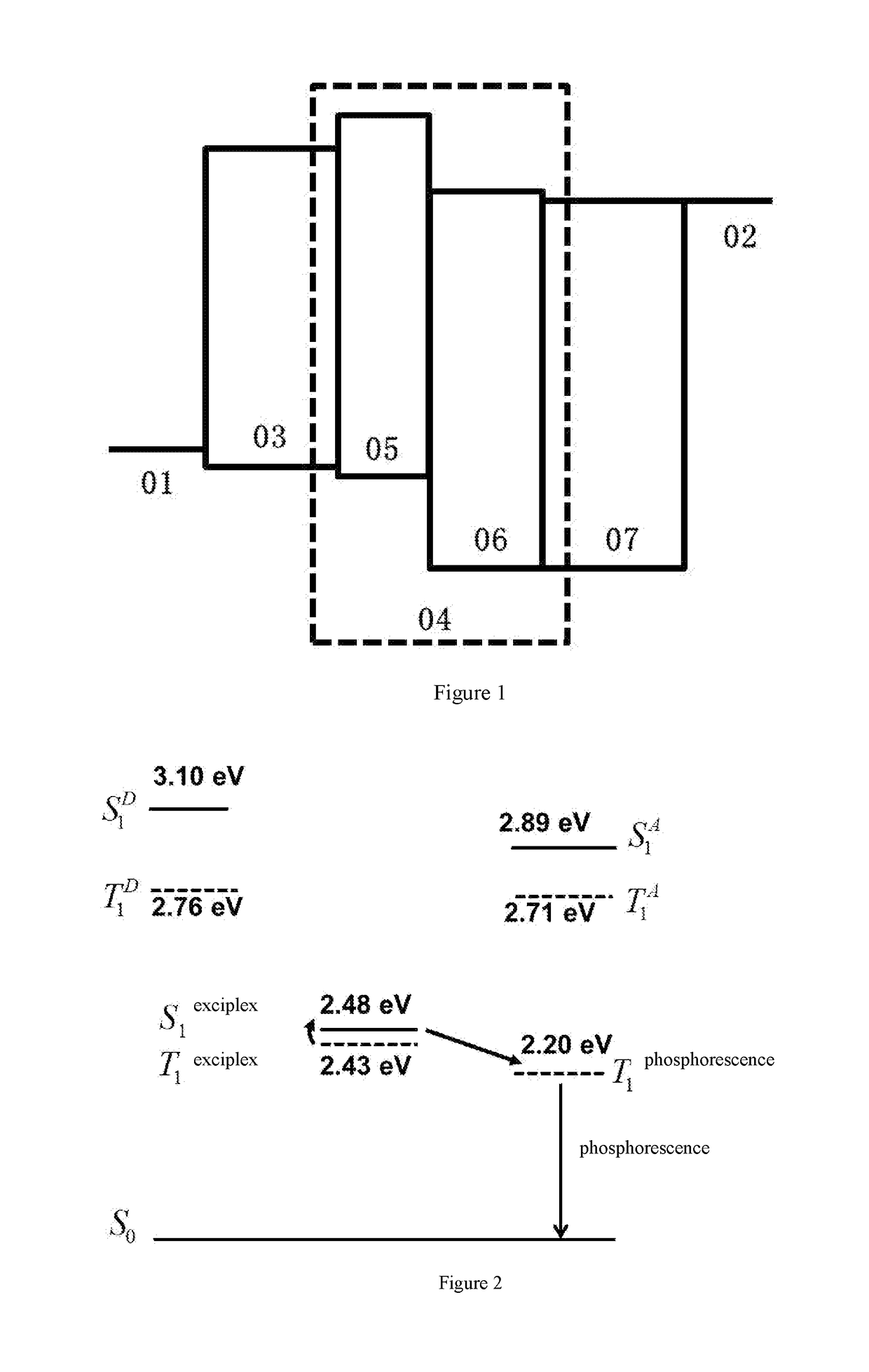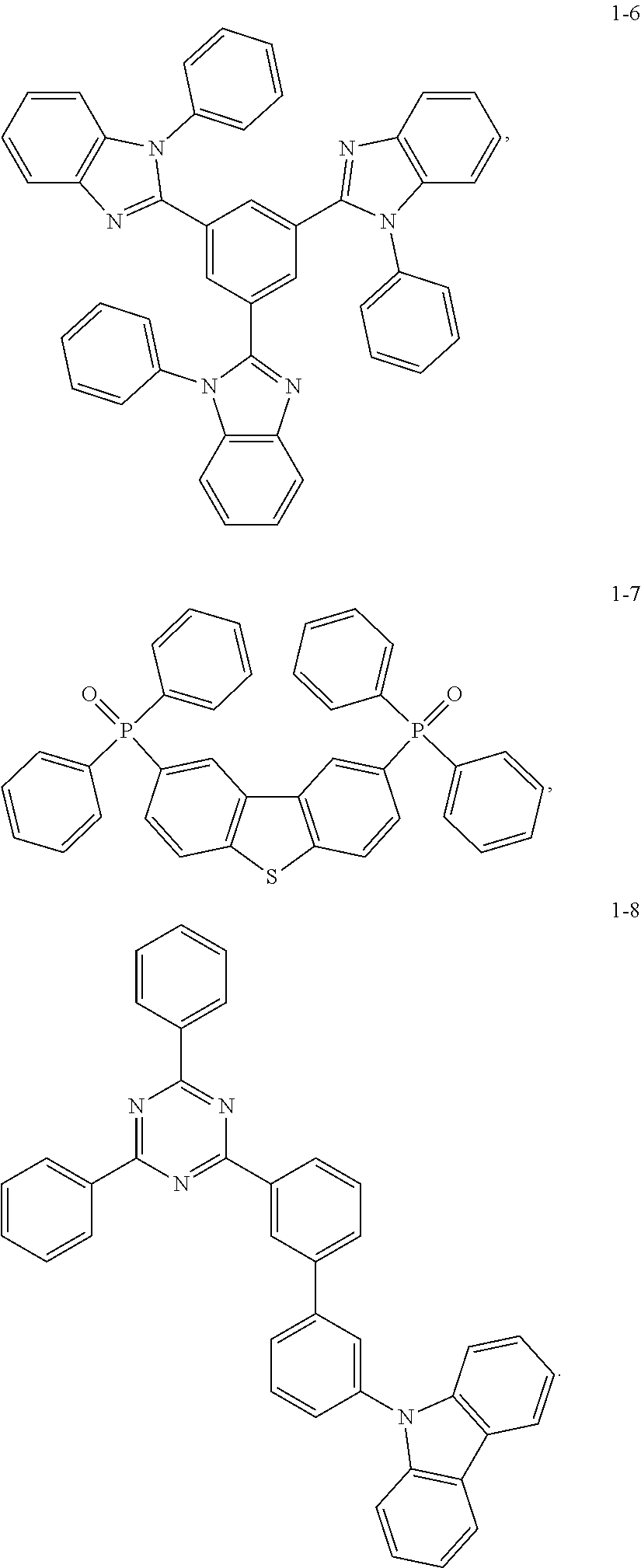Phosphorescent organic electroluminescence devices
a phosphorescent organic and electroluminescent technology, applied in the direction of luminescent compositions, organic chemistry, chemistry apparatus and processes, etc., can solve the problems of reducing device efficiency and high phosphorescent dye doping concentration, and achieves the effect of improving device stability, reducing the doping concentration of phosphorescent dye, and increasing device efficiency
- Summary
- Abstract
- Description
- Claims
- Application Information
AI Technical Summary
Benefits of technology
Problems solved by technology
Method used
Image
Examples
example 1
[0053]In this example, luminescent devices in which a hole transport material layer 05 and an electron transport material layer 06 in a luminescent layer have different thicknesses are manufactured, and these devices have a structure shown as FIG. 1. In the luminescent layer, the hole transport material layer 05 consists of a host material compound (2-5) TCTA, and the electron transport material layer 06 consists of a host material compound (1-8) CzTrz and a phosphorescent dye PO-01. The difference in LUMO energy level between the host compound (2-5) TCTA and the acceptor host compound (1-8) CzTrz is more than 0.3 eV, and the difference in HOMO energy is more than 0.2 eV; and the first singlet state energy level of the exciplex is higher than the first triplet state energy level of the phosphorescent dye. The phosphorescent dye PO-01 accounts for 3 wt % of the luminescent layer.
[0054]The device of this example has the following structure.
[0055]ITO (150 nm) / NPB (40 nm) / hole transport...
example 2
[0070]The device of this example has the following structure.
[0071]ITO (150 nm) / NPB (40 nm) / TCTA (10 nm) / CzTrz+1-10 wt % phosphorescent dye PO-01(30 nm) / Bphen (20 nm) / LiF (0.5 nm) / Al (150 nm)
[0072]The phosphorescent dye PO-01 accounts for 1-10 wt % of the luminescent layer. In this example, different doping concentrations of phosphorescent dye were applied in the luminescent layer for experiments, and the results were shown in Table 2.
TABLE 2ExternalLuminousquantumLifetimeefficiencyLuminanceefficiencyT97Luminescent layer(cd / A)(cd / m2)(%)(hrs)TCTA (10) / CzTrz:58100014.14351 wt % PO-01 (30 nm)TCTA (10) / CzTrz:61100014.74622 wt % PO-01 (30 nm)TCTA (10) / CzTrz:64100016.14803 wt % PO-01 (30 nm)TCTA (10) / CzTrz:57100014.64715 wt % PO-01 (30 nm)TCTA (10) / CzTrz:54100012.944310 wt %PO-01 (30 nm)
[0073]It can be seen from Table 2 that when the doping concentration of the phosphorescent dye in the luminescent layer is 3 wt %, both the external quantum efficiency and the lifetime of the OLED device a...
example 3
[0074]In order to evaluate the influence of the host material on the performance of the organic electroluminescence device of the present invention, an organic electroluminescence device was manufactured by the same method as Example 1, having the following structure:
[0075]ITO (150 nm) / NPB (40 nm) / hole transport material layer (material having hole transport capability) (10 nm) / electron transport material layer (material having electron transport capability +3 wt % phosphorescent dye) (30 nm) / Bphen (20nm) / LiF (0.5nm) / Al (150 nm)
[0076]The performance of the organic electroluminescence device is shown in Table 3 below:
TABLE 3LuminousExternal quantumLifetimeHole transportElectron transportefficiencyLuminanceefficiencyT97Devicematerial layermaterial layer(cd / A)(cd / m2)(%)(hrs)OLED1compoundcompound (1-3) +23100018390(2-7)phosphorescentdye Ir(piq)3OLED2compoundcompound (1-7) +20100016348(2-7)phosphorescentdye Ir(DBQ)2(acac)OLED3.compoundcompound (1-1) +67100017390(2-5)phosphorescentdye Ir(...
PUM
 Login to View More
Login to View More Abstract
Description
Claims
Application Information
 Login to View More
Login to View More - R&D
- Intellectual Property
- Life Sciences
- Materials
- Tech Scout
- Unparalleled Data Quality
- Higher Quality Content
- 60% Fewer Hallucinations
Browse by: Latest US Patents, China's latest patents, Technical Efficacy Thesaurus, Application Domain, Technology Topic, Popular Technical Reports.
© 2025 PatSnap. All rights reserved.Legal|Privacy policy|Modern Slavery Act Transparency Statement|Sitemap|About US| Contact US: help@patsnap.com



